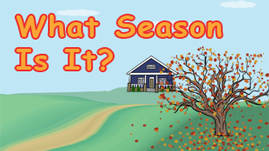Teachers' Domain - Digital Media for the Classroom and Professional Development
User: Preview


KET's Everyday Science is funded in part by Kentucky Power and the American Electric Power Foundation and PNC Bank.
Movement and change. The Earth moves and things change. The days follow one after the other. Seasons come and go. Children can begin to understand these transitions by associating them with the way they affect what we wear and how we play from season to season.
Click on the "view" button on the left to access theWhat Season Is It? interactive. Children can use the clues in the pictures to determine what time of year it is.
This resource is part of the KET Everyday Science collection.
The Earth is always moving. It rotates once every twenty-four hours. This is what causes the sun to appear to come up in the morning and go down, or "set," in the evening. The earth also travels around the sun every 365 days. In summer, the earth is closer to the sun than in winter. That is why the weather is warmer in the summer. In short, all this movement by the earth means change for us.
Children notice these daily and seasonal changes by the way they affect us. We go to sleep when it is dark outside. We wake up with the sun. In spring, we notice the trees start to get leaves, and birds come back from the places they spend the winter. In fall, the leaves on the deciduous trees change color, and eventually fall off as the trees get ready for a long winter's nap. Just like the trees and the birds, people make changes, too. As the seasons change, we change what we wear and how we play outside.
In this interactive, children are asked to look for clues in each picture to choose the season they think is best represented. There is auditory reinforcement for text on the screen to help with word recognition. The question mark with a circle is a clue prompt if a child needs some additional information.
Vocabulary
Spring, Summer, Fall, Winter, warm, hot, cold, trees, birds
 Loading Standards
Loading Standards Teachers' Domain is proud to be a Pathways portal to the National Science Digital Library.
Teachers' Domain is proud to be a Pathways portal to the National Science Digital Library.
